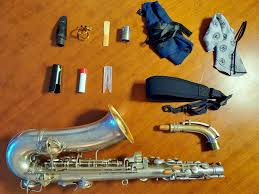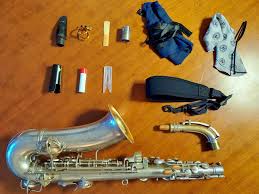Saxophone Hub
Finding the Right Replacement Parts for Your Saxophone

Introduction
When it comes to saxophone maintenance, having access to high-quality replacement parts is essential for preserving sound quality, playability, and the instrument’s longevity. Choosing the right parts, however, can be challenging, as each saxophone has unique specifications, and not all parts are created equal. This guide provides essential tips for identifying and sourcing reliable replacement parts for your saxophone, helping you maintain a high-performance instrument.
1. Identifying the Parts You Need
Common Replacement Parts
Some saxophone parts require replacement more frequently due to regular wear. These commonly replaced parts include:
- Pads: Saxophone pads seal the tone holes and are essential for sound quality. Over time, they wear out and require replacement to prevent air leaks.
- Springs: Springs control key action and tension. When they lose elasticity, they can affect playability and may need replacement.
- Corks: Corks on the neck and keys help with sealing and cushioning. Damaged or dry corks should be replaced to ensure a proper fit.
- Screws and Rods: These small parts help hold the saxophone’s mechanisms together. If screws are loose or rusted, they should be replaced to prevent key issues.
- Neck Straps and Ligatures: These accessories wear out over time and should be replaced if they no longer provide adequate support or security.
Assessing Wear and Damage
Regularly inspecting your saxophone helps identify parts that need replacing. Look for signs of wear on pads, such as fraying, air leaks, or discoloration. Check springs and screws for any looseness or rust, and inspect corks for dryness or cracking. Addressing wear early helps maintain performance and prevent further damage.
2. Understanding Saxophone Part Compatibility
Brand and Model Considerations
Each saxophone brand and model has specific part requirements, so it’s important to know your saxophone’s brand and model when sourcing parts. Branded parts designed specifically for your model ensure better fit and function, reducing the risk of performance issues.
Material and Fit Specifications
Compatibility isn’t just about brand and model. The material and measurements of parts, such as cork or pads, affect how they fit and function. For example, pads need to be the correct thickness and diameter to seal properly, and cork thickness matters for a secure fit on the neck. Checking specifications helps you choose parts that enhance your saxophone’s playability and durability.
3. Where to Source Quality Saxophone Parts
Local Music Stores
Your local music store is a great place to start, especially if they specialize in saxophones or brass instruments. They often carry essential parts like pads, corks, and screws, and may have technicians who can help with installation.
Online Retailers and Reputable Websites
If you can’t find parts locally, reputable online sources offer a wide selection of saxophone parts. Stick to well-known sites like Woodwind & Brasswind, Sax.co.uk, or other trusted music retailers that specialize in saxophones. Avoid unfamiliar or unverified websites, as they may sell low-quality or counterfeit parts.
Consulting Professional Technicians
Working with a saxophone technician can save time and ensure quality. Professional technicians can recommend specific brands and sources for reliable parts and may even handle sourcing and installation for you. Their expertise ensures that you’re getting compatible, high-quality parts.
4. Avoiding Low-Quality Parts and Counterfeits
Signs of Poor-Quality Parts
Low-quality parts can affect your saxophone’s performance and durability. Watch for signs like uneven materials, poor finishing, and lack of branding, which may indicate a part is not authentic. Pads that don’t have a smooth leather finish or springs that feel overly stiff or weak are often signs of low quality.
Risks of Using Substandard Parts
Using low-quality or counterfeit parts can lead to frequent repairs and negatively impact your saxophone’s sound. Poorly made parts often wear out faster and may not fit correctly, leading to air leaks or key malfunctions. Investing in high-quality parts protects your saxophone’s performance and reduces long-term repair costs.
5. How Horns Engineer Can Help with Part Sourcing and Installation
Expert Recommendations and Installation Services
At Horns Engineer, we offer expert assistance with sourcing and installing saxophone parts, ensuring each part is high quality and compatible with your instrument. Our technicians understand saxophone specifications and work with trusted suppliers to provide authentic parts that meet your saxophone’s needs.
Satisfaction Guarantee and First-Time Discounts
We prioritize customer satisfaction by offering free consultations and discounts for first-time customers. Whether you need a simple replacement or a complete overhaul, our team at Horns Engineer is here to help you keep your saxophone in peak condition with reliable parts and professional service.
Conclusion
Finding the right replacement parts is essential for maintaining your saxophone’s sound quality and durability. By identifying compatible parts, sourcing from reputable retailers, and avoiding low-quality parts, you can protect your instrument’s performance for years to come. For expert guidance and part installation, contact Horns Engineer on WhatsApp at +234-813-540-4292 or follow us on social media at Horns Engineer aka Hornsify. Let us help you find the best parts for your saxophone and keep it in top playing condition.
FAQs
1. How do I know if a part is compatible with my saxophone?
Check your saxophone’s brand and model specifications, as these often determine the type and size of replacement parts needed. Consulting a technician can also help ensure you select compatible parts.
2. Where can I buy reliable saxophone replacement parts?
Local music stores and reputable online retailers, such as Woodwind & Brasswind or Sax.co.uk, offer quality saxophone parts. Working with a professional technician is another way to source reliable parts.
3. What are common saxophone parts that need replacement?
Commonly replaced parts include pads, corks, springs, screws, and neck straps. Regular maintenance can help identify when these parts need replacing.
4. How can I tell if a part is low quality?
Signs of low-quality parts include uneven materials, poor finishing, and lack of branding. Authentic parts usually have a consistent finish and come from verified sellers or trusted brands.
5. Why choose Horns Engineer for saxophone part sourcing and installation?
Horns Engineer provides expert recommendations and installation services, ensuring that parts are compatible and high quality. We offer free consultations, satisfaction guarantees, and first-time client discounts to make maintenance easy and reliable.



